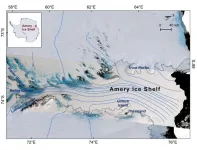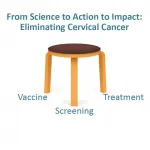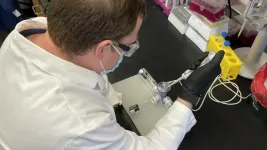NASA's ICESat-2 satellite reveals shape, depth of Antarctic ice shelf fractures
2021-03-04
(Press-News.org) When a block of ice the size of Houston, Texas, broke off from East Antarctica's Amery Ice Shelf in 2019, scientists had anticipated the calving event, but not exactly where it would happen. Now, satellite data can help scientists measure the depth and shape of ice shelf fractures to better predict when and where calving events will occur, according to researchers.
Ice shelves make up nearly 75% of Antarctica's coastline and buttress -- or hold back -- the larger glaciers on land, said Shujie Wang, assistant professor of geography at Penn State. If the ice shelves were to collapse and Antarctica's glaciers fell or melted into the ocean, sea levels would rise by up to 200 feet.
"When we try to predict the future contribution of Antarctica to sea-level rise, the biggest uncertainty is ice shelf stability," said Wang, who also holds an appointment in the Earth and Environmental Systems Institute. "There's no easy way to map the depth of fractures in the field over a regional scale. We found that satellite data can capture the depth and surface morphology of ice shelf fractures and thereby allow us to consistently monitor this information over a large range."
Wang and her colleagues examined high-resolution data collected by the Ice, Cloud and Land Elevation Satellite (ICESat-2) over the Amery Ice Shelf, which is about the size of West Virginia, between October 2018 and November 2019. The satellite shoots green laser pulses to the land surface and uses reflected photons to determine surface height. Whereas other satellites have a resolution of several thousands of feet, ICESat-2 has a resolution of approximately 56 feet, enabling it to see smaller fractures and the fracture morphology.
The researchers then ran the ICESat-2 data through an algorithm that identifies surface depression features to locate and characterize fractures in the ice. They reported their results in the journal Remote Sensing of Environment.
The researchers identified three types of fractures -- U-shaped, parabolic-shaped and V-shaped fractures -- up to 164 feet deep in the ice shelf. They also realized that this surface information provides insights into what is happening hundreds of feet below the surface of the ice.
Basal fracture morphology -- the shape and size of fractures at the base of the ice shelf -- is proportional to the surface depressions, according to Wang. As the glacier that the ice sheet is buttressing accumulates more snow and ice, the parabolic-shaped fractures flow toward the edges of the ice shelf. Once they cross a certain boundary, those surface fractures have a greater potential to penetrate deeper into the ice as the basal fractures extend upward. These fractures can then become V-shaped, potentially signaling that a rift -- a fracture that penetrates the entire thickness of the ice sheet -- has formed. These rifts are more likely to cause calving events.
"Incorporating satellite-based vertical information can improve future ice shelf models," Wang said. "It can help us actually predict calving fronts and where an ice shelf is vulnerable to these events."
INFORMATION:
Other contributors to this study included Patrick Alexander and Marco Tedesco, Lamont-Doherty Earth Observatory at Columbia University and NASA Goddard Institute for Space Studies; Qiusheng Wu, University of Tennessee; and Song Shu, Appalachian State University.
The National Science Foundation and NASA supported this study.
[Attachments] See images for this press release:

ELSE PRESS RELEASES FROM THIS DATE:
2021-03-04
Amsterdam, March 4, 2021 - Cervical cancer is a serious global health threat which kills more than 300,000 women every year. It's a disease that disproportionately affects women in low- and middle-income countries in equatorial Africa, Latin America and Southeast Asia, yet it is a preventable disease and decades of research have produced the tools needed to eliminate it.
Recognizing this urgent public health issue, the editorial team of Preventive Medicine, led by Editor-in-Chief Dr. Eduardo Franco, Director, Division of Cancer Epidemiology and Chair, Gerald Bronfman Department of Oncology at McGill University, is publishing a special issue titled "From Science to Action to ...
2021-03-04
Researchers at the Earlham Institute (EI) have created a new automated workflow using liquid handling robots to identify the genetic basis to prevent plant pathogens, which can be used on a much larger and rapid scale than current methods.
The new EI Biofoundry automated workflow gives scientists an enhanced visual check of genetic mutations linked to the control of crop disease, speeding up analysis to a fraction of the time compared to current methods - from months to weeks - accelerating development of novel products for crop protection in the agricultural industry.
Biosynthesis is the formation of chemical compounds by a living organism, ...
2021-03-04
COSMIC, a multipurpose X-ray instrument at Lawrence Berkeley National Laboratory's (Berkeley Lab's) Advanced Light Source (ALS), has made headway in the scientific community since its launch less than 2 years ago, with groundbreaking contributions in fields ranging from batteries to biominerals.
COSMIC is the brightest X-ray beamline at the ALS, a synchrotron that generates intense light - from infrared to X-rays - and delivers it to dozens of beamlines to carry out a range of simultaneous science experiments. COSMIC's name is derived from coherent scattering and microscopy, which are two overarching X-ray techniques it is designed to carry out.
Its capabilities include ...
2021-03-04
WASHINGTON (March 4, 2021)--Over the next month, 209 U.S. counties in the United States will need to implement crisis workforce strategies to deal with potentially dangerous shortfalls of intensive care unit doctors, according to a new analysis published today. The analysis draws on data from a just launched county-level hospital workforce estimator, one that takes into account the strain on staffing due to the COVID-19 pandemic.
"The shortages could occur just as public health officials warn that variants of the coronavirus are spreading in the United States and could trigger a sharp rise in the number of Americans infected," Clese Erikson, the principal investigator on the project and deputy director of the ...
2021-03-04
An innovative cell-based treatment for cancer has been found promising for the control of infections caused by fungi. A study published in the journal Cytotherapy reports that the use of CAR (chimeric antigen receptor) T-cells programmed to “recognize” Cryptococcus spp. fungi was effective in combating infection in vitro and in mice.
C. gattii and C. neoformans are present in soil with dead organic matter and places contaminated by the droppings of pigeons and other birds. They cause systemic mycoses in the human organism. They can infect the lungs and central nervous ...
2021-03-04
With a relatively minor genetic change, a new treatment developed by researchers at the Georgia Institute of Technology and Emory University appears to stop replication of both flu viruses and the virus that causes Covid-19. Best of all, the treatment could be delivered to the lungs via a nebulizer, making it easy for patients to administer themselves at home.
The therapy is based on a type of CRISPR, which normally allows researchers to target and edit specific portions of the genetic code, to target RNA molecules. In this case, the team used mRNA technology to code for a protein called Cas13a that destroys parts of the RNA genetic code that viruses use to replicate in cells in the lungs. It was developed by researchers in ...
2021-03-04
UNIVERSITY PARK, Pa. -- While women can be drawn into farming for many reasons, researchers in Penn State's College of Agricultural Sciences have found that female-owned farms in the U.S. are more common in areas that are closer to urban markets, that engage in agritourism activity, and that offer greater access to childcare.
The number of farms operated by women has risen over the past two decades, said Claudia Schmidt, assistant professor of marketing and local/regional food systems.
The U.S. Department of Agriculture changed the way it counts the operators of farms in its most recent Census of Agriculture, allowing for up to four principal operators per farm. This has inflated the number of ...
2021-03-04
COVID-19 is only the latest infectious disease to have had an outsized impact on human life. A new study employing ancient human DNA reveals how tuberculosis has affected European populations over the past 2,000 years, specifically the impact that disease has had on the human genome. This work, which publishes March 4 in the American Journal of Human Genetics, has implications for studying not only evolutionary genetics, but also how genetics can influence the immune system.
"Present-day humans are the descendants of those who have survived many things--climate changes and big ...
2021-03-04
To succeed in mating, many male frogs sit in one place and call to their potential mates. But this raises an important question familiar to anyone trying to listen to someone talking at a busy cocktail party: how does a female hear and then find a choice male of her own species among all the irrelevant background noise, including the sound of other frog species? Now, researchers reporting March 4 in the journal Current Biology have found that they do it thanks to a set of lungs that, when inflated, reduce their eardrum's sensitivity to environmental noise in a specific frequency range, making it easier to zero in on the ...
2021-03-04
Brain cells called astrocytes derived from the induced pluripotent stem cells of patients with bipolar disorder offer suboptimal support for neuronal activity. In a paper appearing March 4th in the journal Stem Cell Reports, researchers show that this malfunction can be traced to an inflammation-promoting molecule called interleukin-6 (IL-6), which is secreted by astrocytes. The results highlight the potential role of astrocyte-mediated inflammatory signaling in the psychiatric disease, although further investigation is needed.
"Our findings suggest that IL-6 may contribute to defects associated with bipolar disorder, opening new avenues for clinical intervention," says co-senior study author Fred Gage ...
LAST 30 PRESS RELEASES:
[Press-News.org] NASA's ICESat-2 satellite reveals shape, depth of Antarctic ice shelf fractures




